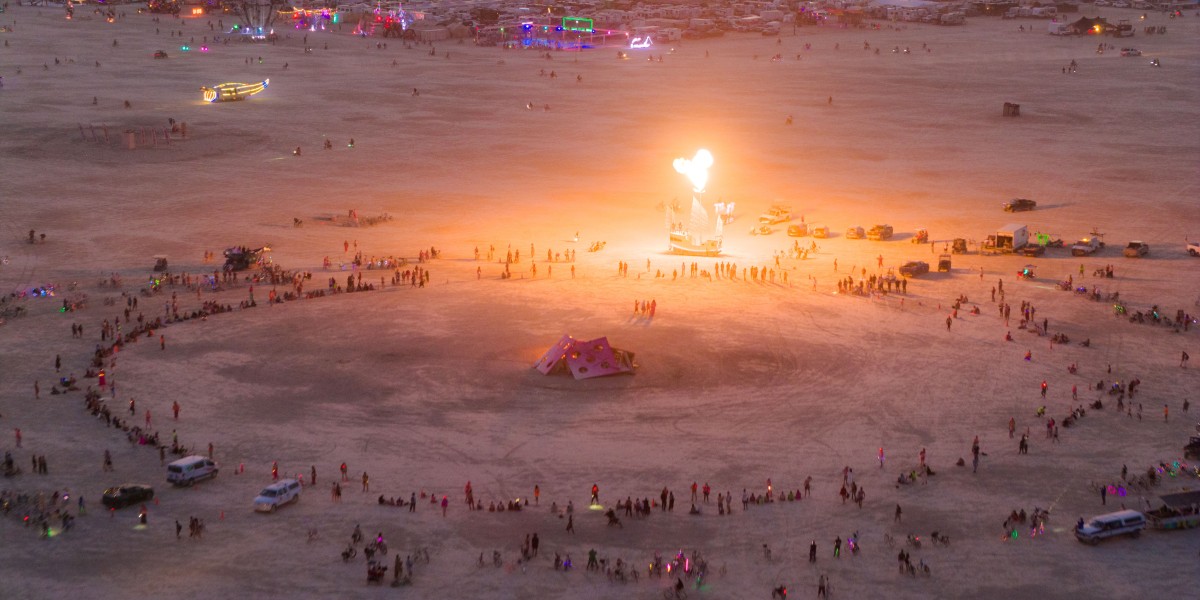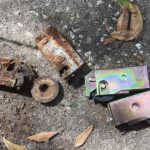BLACK ROCK DESERT, NV, Sep 2025 – The wind roared across the playa, gusting at speeds up to 70 miles per hour. In mere moments, shade structures buckled, tents were swept away, and a 27-foot-tall pink dice sculpture, still incomplete, crumbled to the ground. What had started as a relatively calm build week at Burning Man 2025 quickly turned into one of the most destructive storms the event has seen in over a decade, toppling sculptures and drastically altering the fate of several major installations.
Among the hardest hit was Mona DIE! DIE! DIE!, the final piece in a trilogy by artist Miao He, following the 30-foot pink Mona Bunny and the mystical Mona Mushroom. The sculpture—a massive wooden die painted in bright pink—was meant to explore themes of fate, chance, chaos, and impermanence, encouraging participants to embrace uncertainty and “roll with it.” And this year, the playa certainly provided plenty of chaos to engage with.
As the build crew was lowering the third die piece into place, a rare dust storm arrived unexpectedly, reducing visibility to an arm’s length and tipping over the forklift that was holding the piece. The die groaned, then collapsed, shattering into pieces before it could be completed. Benjamin Brast-McKie, a member of the build crew, commented: “When you call upon chaos, you don’t always get to choose what you get.”
However, the story didn’t end with the destruction—it marked a new beginning for the piece.

Embracing Chaos: A New Chapter
Instead of hiding the damage, the team chose to incorporate it into the artwork. In an act of improvisation, the team reassembled the remaining die faces into a pyramid, with the shattered surfaces forming new entry points. The piece was transformed into an interactive installation that people could climb, much like ancient ruins. Participants stepped through the cracks, engaging with the artwork’s fragility, which was no longer seen as failure but as an integral part of its life cycle. “I could not have come up with a better depiction of chaos by myself,” reflected project lead Janis K. Hesse. “Nature inadvertently became our collaborator. She fractured the artwork into many pieces, but at the same time made it more complete than we ever could have planned.”
Mona DIE! DIE! DIE! was one of three large art pieces destroyed by the storm on Saturday. In a twist of poetic irony, one observer noted that nature seemed to have targeted the installations that most resonated with the themes of impermanence and resilience.
Black Cloud: From Ominous Presence to Message of Fate
Not far from Mona DIE! DIE! DIE!, Ukrainian artists led by Oleksiy Sai unveiled Black Cloud, a monumental inflatable sculpture symbolizing the destructive force of war. Hours before Ukrainian Independence Day, the storm tore it apart. Afterward, the fragmented remains were reassembled into letters spelling out a powerful statement across the playa: “No Fate,” referencing the idea that “there is no fate but the one we create for ourselves,” as explained by lead producer Vitaliy Deynega. What had begun as a symbol of looming threat was transformed into a declaration that the future, though uncertain, is still ours to shape.
Resilience: Rebuilt from the Ashes
Whitney Webb and a group of North Carolina artists who had survived Hurricane Helene built Resilience from the debris of their own homes as a tribute to the process of rebuilding after devastation. While building on playa, the Burning Man storm capsized the trailer and demolished their art piece in the process. The artists decided to rebuild it right there on the spot with whatever materials the desert left them. “I’ve always said that resilience isn’t just about surviving the storm, it’s about what you build from the wreckage. Now we’re doing that in real time… It’s even more resilient now,” Webb recalled.
A Funeral for Art: Mona’s Final March and Burn
To honor the art pieces destroyed in the storm, the Mona team led a jazz funeral parade, New Orleans-style, from Center Camp to Mona DIE! DIE! DIE!, stopping along the way for interactive performances at various art installations. The parade culminated in the burning of the damaged piece. Participants organized a symposium with talks on impermanence, and created their own death masks representing their external identities, which were burned in a pink coffin along with remnants of the destroyed artwork, to reveal their true selves. Artists whose pieces were also destroyed contributed pieces of their sculptures to the coffin, and after eulogies and performances, the coffin was placed inside the dice and set ablaze in a dramatic fire display.
“I’m proud of how our team handled the collapse of our art piece,” said Janis K. Hesse. “It’s easy to call something like this a failure and give up. But leaning into the theme of our piece, our team really did embrace the chaos and created a new sculpture with deeper meaning. The storm didn’t destroy Black Rock City but it brought us closer together, turning chaos into something unexpectedly beautiful.”
The Playa as Co-Author
Together, these works show how art at Burning Man 2025 was not so much destroyed as rewritten. Black Cloud scattered into No Fate. Resilience was rebuilt twice. Mona DIE! DIE! DIE! taught its creators how to embrace chaos and impermanence. In the Black Rock Desert, art is never static. It evolves continuously, shaped by the people who create it, the forces of nature, and the unpredictable. Through this transformation, the meaning of the art deepens, making each piece even more profound by the end of the event. “We prepared the funeral, but nature decided the timing,” Miao He said, reflecting on the three “deaths” of the art piece. “The first death came from the storm, the second from fire, and the third will be when people forget it—but that’s in the distant future.”
About Mona Art Foundation
Miao He, born in a small rural village in China, graduated from the China Academy of Art and founded the Mona Art Foundation, a nonprofit dedicated to supporting marginalized artists and exploring art’s impact on mental health. This year, the foundation sponsored several art installations at Burning Man, including WiFi Jail, an interactive piece designed by children ages 6 to 13 that resembled a prison cell. By placing participants inside to access free WiFi while others watched from the outside, the piece prompted a confrontation with digital addiction. “We give away our attention too easily,” said lead artist Weisen Wang. “People don’t look up anymore.” WiFi Jail reminded participants that true freedom may lie not in constant connection, but in choosing when to disconnect and reconnect face-to-face.
A light show led by Chinese artist Quansheng Li projected art from over ten international artists, including Yang He and Bowei Wang, onto the remaining sides of the cube. Mona Art Foundation also supported students showcasing their artwork and music at Center Camp during the Mona Funeral March and enabled international artists to project their digital creations onto the die faces at night. The foundation is currently producing a documentary on Miao He and the unfolding story at Burning Man this year, set for release next year.
Acknowledgments
Build Team: Mackenzie Pelletier, Benjamin Brast-McKie, Janis K. Hesse, Sparkle Pony, Renzo Verbeck, Nathan Heintz, Irene Rembado, Brian Gonzales, Ke Ming, Helen Yu, Grant Gordon, Robert Tromm, Jay Calleton, Aron Parks, Evan, Drew Wilson, Ryan Hubbs.
Documentary Team: Jing Wen, Paul Chelmis, Denis Pacuraru, Jessica Yuan, Ruoyun Tang
Video Art Unit Artists: Quansheng Li, Yang He, Bowei Wang, Zhaojun Liu, Sikey Wong, Haiyang Hu, Aiju Wang, Charmaine Lacsina, Jingxuan Hu, Yichu Li, Mantou Lin, Sophia Guo
Speakers and Performance Artists for Funeral March: Janis K. Hesse, Miao He, Philip DePoala, Charmaine Lacsina, Inani Schroedinger, Nicky Mehtani, Ben Brast-McKie, Rae Gross, Nathan Heintz, Irene Rembado, Leonardo Christov-Moore, Liz “Reality” Kilkenny, Shai Yeshanov, Kian Locke, Anthony Moreno, Julep de Soie
Burn Team: Al Stahler, Scott Ashkenaz, Grant Gordon, Kenneth Shinozuka
Youth Project “Phone Cell” (WiFi Jail) lead artists: Weisen Wang, Jason Wang, Yimo Wang, Yichen Dong, Ziyuan Fang, Yifei Peng, Yiyue Peng, Rongyi Li, Rongxing Li
Contributing artists: Yige Xie, Yaxuan Zhu, Houxiang Wang, Junyu Li, Mooie&Gala, Qi Haoran
Mona Art Foundation Support Team: Miao He, Monica Hsu, Yaqin He, Weiqiang Huang, Ruoyan Wang, Yue Yao

















